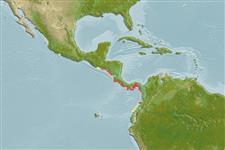>
Gobiiformes (Gobies) >
Microdesmidae (Wormfishes) > Microdesminae
Etymology: Cerdale: Greek, kerdoo, -oos, ous = the wary one, the wily one or the fox. Fishes of Alaska, Jordan and Evermann, 1898; personnal communication of Catherin W. Mecklenburg, California Acad, of Sciences.
More on authors: Jordan & Gilbert.
Environment: milieu / climate zone / depth range / distribution range
Écologie
marin démersal; profondeur 0 - 1 m (Ref. 11482), usually 0 - 1 m (Ref. 11482). Tropical
Eastern Central Pacific: Costa Rica to Colombia.
Taille / Poids / Âge
Maturity: Lm ? range ? - ? cm
Max length : 7.5 cm TL mâle / non sexé; (Ref. 11482)
Inhabits shallow rocky coasts, including tide pools. Feeds on zooplankton and tiny benthic crustaceans.
Life cycle and mating behavior
Maturities | Reproduction | Spawnings | Egg(s) | Fecundities | Larves
Allen, G.R. and D.R. Robertson, 1994. Fishes of the tropical eastern Pacific. University of Hawaii Press, Honolulu. 332 p. (Ref. 11482)
Statut dans la liste rouge de l'IUCN (Ref. 130435)
Menace pour l'homme
Harmless
Utilisations par l'homme
Outils
Articles particuliers
Télécharger en XML
Sources Internet
Estimates based on models
Preferred temperature (Ref.
123201): 27.3 - 29.1, mean 28.2 °C (based on 110 cells).
Phylogenetic diversity index (Ref.
82804): PD
50 = 0.5312 [Uniqueness, from 0.5 = low to 2.0 = high].
Bayesian length-weight: a=0.00389 (0.00180 - 0.00842), b=3.12 (2.94 - 3.30), in cm total length, based on all LWR estimates for this body shape (Ref.
93245).
Niveau trophique (Ref.
69278): 3.5 ±0.47 se; based on food items.
Fishing Vulnerability (Ref.
59153): Low vulnerability (10 of 100).
